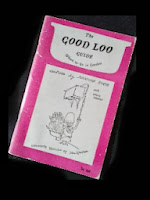For a while, I assumed this was just pure confusion - not least because Jennings' firm, after his death, went on to install and run many public toilets in London in the early 1900s.
Then I found Jennings' letter to the City of London from 1858, actually offering to build an underground public toilet - so there was some fact behind the mistaken attribution. But, tragically, the accompanying illustration was missing from the City archives ... or so I thought.
It was only after some more digging that:
i. I found a useful reference to Jennnings' underground toilets in the Science Museum Archive
ii. I then remembered that Sarah McCabe had remarked upon the same reference in her master's thesis on late Victorian public toilets (generously emailed for my perusal - many thanks again, Sarah)
The illustration was not lost at all ... indeed, here it is, courtesy of those lovely people at the Science Museum:
 |
| Copyright: Science Museum Archives |
The background, I think, is a generic City-scape, although I'm willing to be corrected. This is surely the same plan sent to the City of London, although this copy was sent to Capt. Francis Fowke, Director of Works at South Kensington Museum, with a view to it appearing in the 1862 International Exhibition (Jennings would also design and run the toilets at the 1862 Exhibition).
The seat on the left is the attendants room, not a toilet (as the fact that it is unconnected with the drainage, and the overview shows):
 |
| Copyright: Science Museum Archive |
No wonder, then, that people have latterly been keen to attribute the work to Jennings himself (who inconveniently died in 1882). Nor that Jennings is reputed to have nurtured a grievance against the City authorities.
Note also the public drinking fountain at the ground level - the latest thing in sanitary improvement in 1850s London when the toilets were designed (Haywood did not bother to copy this in the 1880s).
The best bit of the drawing, of course, is the mid-Victorian gentleman nonchalantly emerging from the WC.
 |
| Copyright: Science Museum |
Victorian urinals would have the instruction 'Please adjust your dress before leaving' painted upon the wall (or, in the case of cast iron urinals, even embossed upon the metal - as one rare surviving example at Twickenham shows). At least our gentleman has paid heed to that injunction.
 |
| [thanks to JL for the image] |
Possibly I am already in too deep.
But - if you have good pics of mid-Victorian trousers and their buttons, I'd like to see them.


Great post as usual. Were these public toilets only for the gents? Would ladies have been expected to return home to appease the call of nature?
ReplyDeletep.s. there will be a chapter on this in the book I'm writing - out next Autumn!
DeleteYes, the 1885 underground toilets were for gents. The first above-ground ladies toilets had been tried at Ludgate Circus but the City wasn't that keen. The first underground ladies would appear in the West End, and then, grudgingly, the idea was adopted throughout London. Ladies either contained themselves, or sought toilets at shops and railway stations (although the former was generally a matter of asking the shopkeeper especially, rather than our current signposted arrangements).
ReplyDeleteThis what you want?
ReplyDeletehttp://19thcentury.wordpress.com/2007/11/04/victorian-mens-wear-fall-front-trousers/
Ha! Thanks - brilliant.
Deletewhy does it say SHEWING instead of SHOWING?
ReplyDeleteJust an old spelling.
DeleteAbout the spelling: It was common to spell any word the way it sounded to the writer; hence, one would expect to see any number of regional efforts at spelling. During the Olde English era (circa Lady McBeth), this practice is most evident.
ReplyDeletelady MacBeth was Scottish - would not have spoken English!!
ReplyDelete